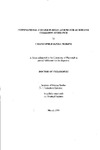INTERNATIONAL COLLISION REGULATIONS FOR AUTOMATIC COLLISION AVOIDANCE
| dc.contributor.author | PERKINS, CHRISTOPHER JAMES | |
| dc.contributor.other | Faculty of Science and Engineering | en_US |
| dc.date.accessioned | 2013-10-22T09:25:18Z | |
| dc.date.available | 2013-10-22T09:25:18Z | |
| dc.date.issued | 1996 | |
| dc.identifier | NOT AVAILABLE | en_US |
| dc.identifier.uri | http://hdl.handle.net/10026.1/2270 | |
| dc.description.abstract |
This thesis considers the relationship between collision regulations and an automatic collision avoidance system (ACAS). Automation of ship operations is increasingly common. The automation of the collision avoidance task may have merit on grounds of reduced manual workload and the elimination of human error. Work to date by engineers and computer programmers has focused on modelling the requirements of the current collision regulations. This thesis takes a new approach and indicates that legislative change is a necessary precursor to the implementation of a fully automatic collision avoidance system. A descriptive analysis has been used to consider the nature of the collision avoidance problem and the nature of rules as a solution. The importance of coordination between vessels is noted and three requirements for coordination are established. These are a mutual perception of: risk, the strategy to be applied, and the point of manoeuvre. The use of rules to achieve coordination are considered. The analysis indicates that the current collision regulations do not provide the means to coordinate vessels. A review of current and future technology that may be applied to the collision avoidance problem has been made. Several ACAS scenarios are contrived. The compatibility of the scenarios and the current collision regulations is considered. It is noted that both machine sensors and processors affect the ability to comply with the rules. The case is made for judicial recognition of a discrete rule-base for the sake of an ACAS. This leads to the prospect of quantified collision regulations for application by mariners. A novel rule-base to match a pm1icular ACAS scenario has been devised. The rules are simple and brief. They avoid inputs dependent on vision and visibility, and meet all the aforementioned coordination requirements. Their application by mariners to two-vessel open sea, encounters was tested on a navigation simulator. The experimental testing of such a rule-base is unique. Mariners were given experience of applying the rule-base in certain circumstances and asked by questionnaire what their agreeable action would be. This was compared with their usual action. While the number of experiments was small, an indication was given of the impm1ant issues in applying a quantified rule-base. Aspects identified for fm1her study include the testing of rule base elements in isolation, and the use of quantified rules in multi-ship and confined water encounters. | en_US |
| dc.description.sponsorship | The Nautical Institute | en_US |
| dc.language.iso | en | en_US |
| dc.publisher | University of Plymouth | en_US |
| dc.title | INTERNATIONAL COLLISION REGULATIONS FOR AUTOMATIC COLLISION AVOIDANCE | en_US |
| dc.type | Thesis | |
| dc.identifier.doi | http://dx.doi.org/10.24382/3812 |
Files in this item
This item appears in the following Collection(s)
-
01 Research Theses Main Collection
Research Theses Main


